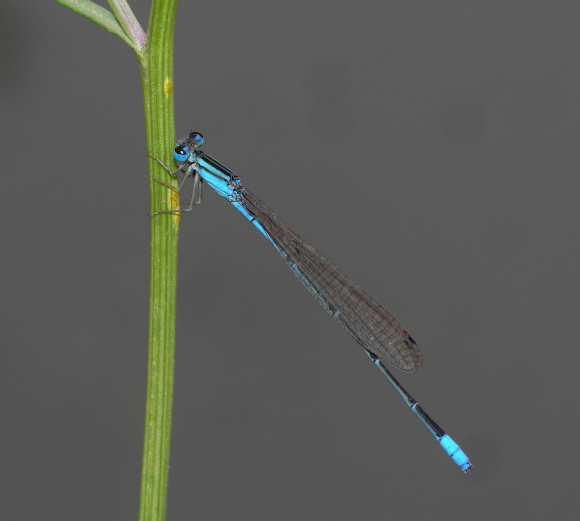Genus Africallagma Kennedy, 1920
African bluets
Synonyms:
- scientific: Enallagma Charpentier, 1840 (in part); Ischnallagma Kennedy, 1920 [elongatum]; Libyagrion Fraser, 1928 [decoloratum = subtile]
Type species: Agrion glaucum Burmeister, 1839
Introduction
The twelve species are endemic to Africa (one in Madagascar) and were formerly placed in Enallagma. They are small (hindwing 13-22 mm) slender damselflies favouring stagnant and marshy, often temporary, conditions. Most are found in open landscapes, often in highlands, and are largely blue with maturity. A. pseudelongatum is found in shady forest swamps, as is the rather black and greenish A. vaginale, also in lowlands. A. cuneistigma is restricted to stream pools at 1500-1600 m in the Chimanimani Mts of eastern Zimbabwe. Young Africallagma males are brownish, often with a pinkish hue. The thorax is often marked with black, but sometimes these markings are much reduced or faded to brown, appearing as ‘ghost’ stripes. It appears many species occur in both dark and pale forms, although in A. glaucum the dark form predominates, and in A. pallidulum and A. subtile the pale form: characters of markings should therefore be used with care and certain identification relies on the appendages. Beware of confusion with similar genera, especially Aciagrion (see that genus). [Adapted from Dijkstra & Clausnitzer 2014]
Diagnosis
Genus similar to Aciagrion by (a) size, Hw 13-20 mm; (b) mesostigmal plates (narrow plate anterior to mesepisterna immediately posterior to prothorax) dorsally with raised flap- or knob-like ridges; (c) humeral stripe at most 2x as wide as antehumeral stripe; (d) Pt in Fw and Hw similarly coloured; (e) Pt pale brown, elongate, anterior border longer than proximal border; (f) cerci not branched, often with triangular ventral process (best seen in caudal view); (g) cerci and paraprocts not bifid, latter with dorsal spine but without inferior bulge; (h) base of paraproct usually much swollen, resulting in prominent inferior bulge. However, differs by (1) Cux stands distal from origin of anal vein by about its own length, rather than at the origin of the anal vein. [Adapted from Dijkstra & Clausnitzer 2014]

Africallagma elongatum (Martin, 1907). Male © Oleg Kosterin

Africallagma glaucum (Burmeister, 1839). Male (pale) © Allan Brandon
Map citation: Clausnitzer, V., K.-D.B. Dijkstra, R. Koch, J.-P. Boudot, W.R.T. Darwall, J. Kipping, B. Samraoui, M.J. Samways, J.P. Simaika & F. Suhling, 2012. Focus on African Freshwaters: hotspots of dragonfly diversity and conservation concern. Frontiers in Ecology and the Environment 10: 129-134.
References
- May, M.L., and Dijkstra, K.-D.B. (in prep). Keys and distributional data for African damselflies of the genera Africallagma, Azuragrion, Pinheyagrion and Proischnura, with taxonomic notes and the description of a new species of Africallagma. Zoologische Mededelingen. [PDF file]
- Dijkstra, K.-D.B, and Clausnitzer, V. (2014). The Dragonflies and Damselflies of Eastern Africa: handbook for all Odonata from Sudan to Zimbabwe. Studies in Afrotropical Zoology, 298, 1-264.
Citation: Dijkstra, K.-D.B (editor). African Dragonflies and Damselflies Online. http://addo.adu.org.za/ [2024-10-31].

